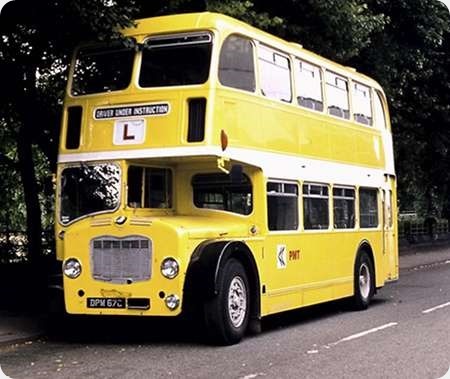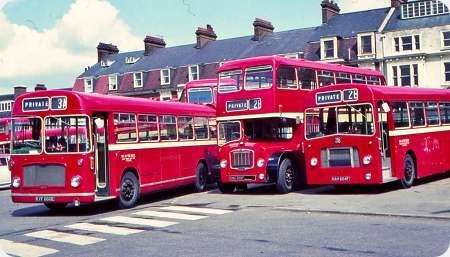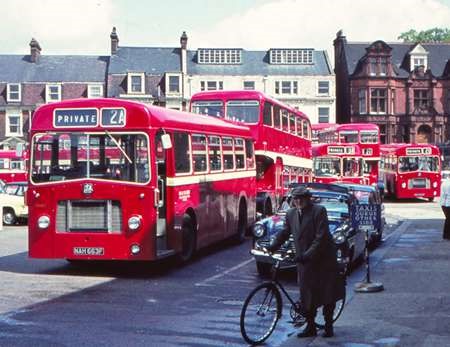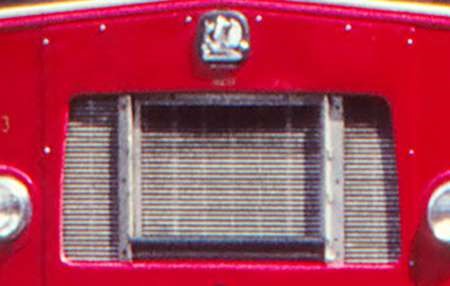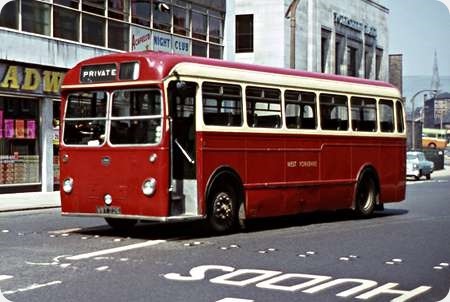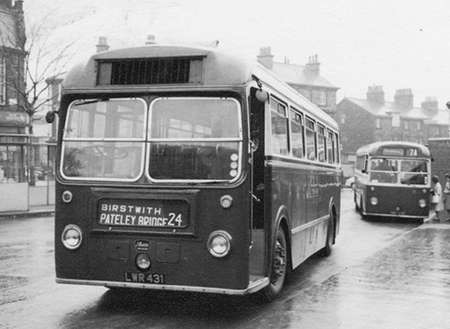Potteries Motor Traction – Bristol FS6G – DPM67C – T2
Potteries Motor Traction
1965
Bristol FS6G
ECW H33/27RD
New to Brighton Hove and District as fleet number 67 this was one of a pair of these Lodekkas acquired by PMT in NBC days as Driver Training vehicles. The yellow NBC style livery is rather attractive. Seems a strange vehicle type to transfer to an ex BET fleet with no previous experience of this model.
Photo taken at Woodhouse Street, Stoke outside the main works in July 1978
Photograph and Copy contributed by Ian Wild
22/04/20 – 06:46
These two buses were added to the PMT fleet at the end of 1976 and if my memory serves me right one was received in NBC green whilst the other had traditional Southdown livery. These buses were newer than all of the Leyland Atlanteans and most of the Daimler Fleetlines still in operation at that time, but these were not suitable for Driver Traning duties by virtue of having semi-automatic transmission. At that time to obtain a licence to drive all type of PSV a driver had to have undertaken at least part of the PSV training on a bus with fully transmission.
Leekensian
23/04/20 – 06:40
Thanks for the comment. In 1976 PMT would still have Ford coaches with manual transmission (and maybe Reliances 986-991 and 1041 -1043, possibly some Reliance service buses still with manual transmission). Most BET fleets had gone over to forward entrances for their later half cab deliveries and rear entrance buses were easier (and cheaper) to adapt for driver training. An interesting interlude and interesting comment about liveries as received.
Ian Wild
23/04/20 – 08:27
I agree that the livery is quite attractive, probably aided by how impeccable the bus looks.
Is it still or no longer the case that PSV drivers must have some experience of manual transmission? The Stagecoach learner buses I see around locally (all single deckers, although the fleet has double deckers, too) are so old as to suggest that they have manual gearboxes. They are of the high-floored variety coach type with steep steps into the vehicles.
Chris Hebbron
24/04/20 – 06:08
In 1976 PMT still had a large number of Leyland Leopards and AEC Reliances from the batches delivered between 1962 and 1965 – 921 to 950, 976 to 985 and 1036 to 1040. One of 1963 Leopards (927) was converted to a Driver Trainer in 1977 and carried the same livery as the two Bristol FS6G. Unfortunately all of the heavy weight(some might say decent) coaches had been withdrawn by PMT in 1973 to be replaced by twenty Ford coaches with Duple Dominant Express bodywork. I have often wondered if the coaches were withdrawn prematurely to take advantage of the bus grant scheme or in order to improve the profile of the coach fleet. A further link between PMT and Southdown also took place in 1976 when six 1965 Leyland Leopards coaches were purchased and carried PMT fleet numbers 10 to 15.
Leekensian
24/04/20 – 06:09
Chris-so far as I am aware the use of high floor coaches is more to do with a requirement that buses used for PCV licence testing (and hence training) are fitted with ABS brakes. Modern coaches are so fitted (again by law) hence meet the required standard.
Ian Wild
25/04/20 – 06:29
Ian; When this came into force my local operator, First Eastern Counties, had to use the newest Volvo coaches (R reg) for driver training and the N&P reg ones for revenue earning services.
Shortly before the ABS requirement I had passed my class D driving test in a 26 year old Bedford YMT which obviously did not have ABS.
Nick Dasey
26/04/20 – 06:10
Even when delivered in 1966, the FS did not appear to be the bus for the future of the industry! Several of the last batch went to Tilling companies that already used FLF forward entrance deckers. So why revert? I recall United Counties had several of this last batch, with the reliable 6LW Gardner engine and without CBC radiators and thus engineering-wise were very reliable vehicles. But not much use when one man operation of double deckers came to the industry within two years of the delivery. United Counties carried out careful conversions of four of their last FS6G into Driver Trainers and, in at least one case, combined with tree lopping duties, complete with trailer for carrying the cuttings. They were out-shopped from Northampton similarly to the PMT version in an immaculate yellow version of the NBC livery. I think samples are still running and there are photos on Flickr. PS: I remember collecting Eastern Counties last FS5G from Lowestoft in 1966!
Geoff Pullin
26/04/20 – 06:12
Nick, I really admire your gall to go public on this site to say that you passed your test in a Bedford!
Perhaps our illustrious ‘blogmaster’ could start a separate topic heading, so that we might be able to regale tales of what we passed our PSV test with?
just an idea? (Tin hat time from our beloved Bedford fans, I fear )
Mike Norris
27/04/20 – 07:25
Mike, you think that admitting to passing a test in a Bedford is bad, it get’s worse. I also passed my class 3 & 1 HGV tests in Bedfords and worst of all, I still own the coach.
Nick Dasey
27/04/20 – 07:25
Well, I learned and passed my test in a magnificent (6 speed) 6U3ZR. Of course, purists might (justifiably?) say that learning and passing on a constant mesh decker is something of which to be more proud.
David Oldfield
27/04/20 – 07:27
I passed my PSV test on either DPM66C or DPM67C I don’t recall which one, having trained on both of these buses whilst at PMT in 1978. My assessment was undertaken on the aforementioned Leyland Leopard 927 (927 UVT).
Leekensian
28/04/20 – 06:27
I did my initial PSV training at PMT on dual control (and Metalastik toggle link suspension fitted) AEC Reliance 470 5596. I progressed to PD2 L466 (which suited me as it had a sliding cab door) and finally PD2 L337 which I wasn’t keen on. The Instructors were Gerry, Sam And George Clews who was the Examiner. He somewhat reluctantly advised me that I had passed my test. Something about being an Engineer, I wouldn’t have to drive a bus in anger!!! Happy days
Ian Wild
29/04/20 – 06:24
I recall that the primary use of T5596 was to train Conductors in order to obtain a Car licence.
George Clews took me on an assessment to drive a Company car but my PSV test was undertaken by a Ministry Examiner. The man in charge of the PMT car pool was an affable man, Bill Corden who I remember was also the Chauffeur to the General Manager. His initial greeting when encountering him was ‘haven’t we got good jobs’. Indeed happy days.
There is a link on the SCT’61 site regarding T5596.
Leekensian
30/04/20 – 05:54
I remember Bill Corden, great bloke in charge of the private car garage. Bill was very helpful and encouraging to me. His usual greeting to me was ‘How’s the fleet!"
Characters!!
Ian Wild
Quick links to the - Comments Page - Contact Page - Home Page
